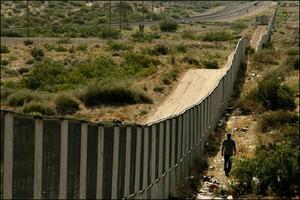Border securityCritics call for end of physical border wall program along southern border
Given the current congressional economic climate with politicians on both sides of the aisle looking to cut programs and reduce the deficit, various groups are calling for the cancellation of the physical border wall along the U.S.-Mexico border; critics cite the wall’s high costs, detrimental environmental impact, and inability to stop people from crossing the border as reasons to end the program; so far the government has spent $2.6 billion to build 650 miles of fence and would cost $6.5 billion over the next twenty years to maintain it; a recent YouTube video showed two women climbing the fence in less than twenty seconds; environmentalists say the walls have “severely affected rivers, streams, and wetlands”

Critics want fence program ended // Source: charlestonteaparty.org
Given the current congressional economic climate with politicians on both sides of the aisle looking to cut programs and reduce the deficit, various groups are calling for the cancellation of the physical border wall along the U.S.-Mexico border.
After DHS cancelled SBInet, its $1 billion virtual border fence project that that proved ineffective, critics of the current physical fence project are increasingly calling for the end of the program as well. Opponents cite the wall’s high costs, negative impact on the environment, and its inability to stop people from crossing the border as reasons to end the program.
So far the government has spent $2.6 billion to build 650 miles of fence along the southern border and the Government Accountability Office (GAO) estimates that it would cost $6.5 billion over the next twenty years to maintain the fence.
In an embarrassing blow to the program, a recent YouTube video showed two women climbing the fence in less than twenty seconds.
In a further blow to the program, Mike Scioli, a spokesman for U.S Customs and Border Protection (CBP), said, “The border fence is a speed bump in the desert.” While Randy Hill, the former CBP chief for the Del Rio, Texas portion of the border, said that the walls would only “slow down illegal crossers by minutes.”
Scott Nicol, the co-chair of the Sierra Club’s Borderlands Teams, in a Christian Science Monitor op-ed, discusses the environmental damage that the physical fence has caused.
Nicol says that the walls have “severely affected rivers, streams, and wetlands.”
As evidence, he points to the Otay Mountain Wilderness Area south of San Diego, where “DHS dynamited 530,000 cubic yards of rock from mountainsides and dumped the waste into the Tijuana River” to build walls.
While, “In Arizona, border walls have acted as dams across washes and streams in the Organ Pipe Cactus National Monument, leading to severe erosion and flooding.”
According to Nicol, the construction of the wall has violated the “Wilderness Act, the Clean Water Act, the Endangered Species Act, and a host of other federal laws” and that in constructing the border fence, the Secretary of Homeland Security was granted the rare ability to bypass these laws.
Nicol says, “No one else, not even the president, has this power.”
In 2005 Congress granted DHS the ability to waive any laws that interfered with the construction of physical barriers along the border.
In the construction of the border fence, “the Farmland Protection Policy Act, the Religious Freedom Restoration Act, and the Native American Graves Protection and Repatriation Act” were also waived.
Given the physical border fence’s cost, environmental impact, and failures, Nicol concludes by asking, “At a time when Congress is proposing deep cuts to federal spending, can we really afford a $2.6 billion speed bump?”
